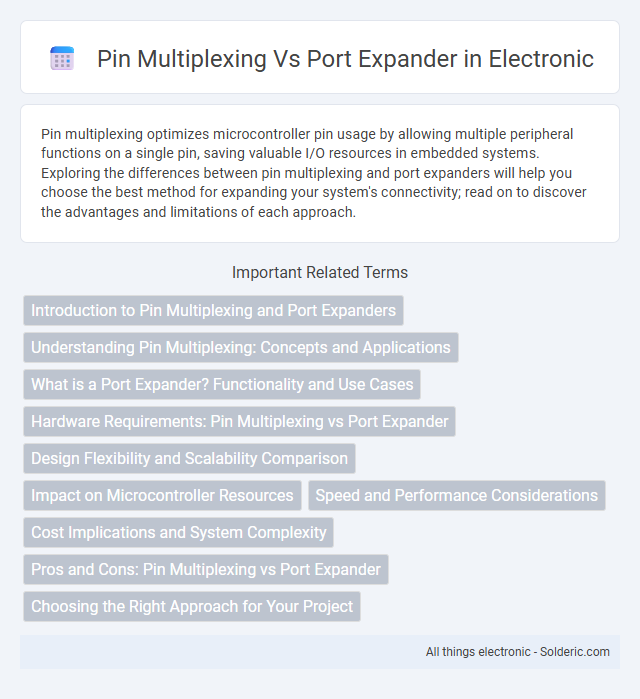Pin multiplexing optimizes microcontroller pin usage by allowing multiple peripheral functions on a single pin, saving valuable I/O resources in embedded systems. Exploring the differences between pin multiplexing and port expanders will help you choose the best method for expanding your system's connectivity; read on to discover the advantages and limitations of each approach.
Comparison Table
| Feature | Pin Multiplexing | Port Expander |
|---|---|---|
| Function | Shares physical pins for multiple functions | Adds extra digital input/output pins to microcontroller |
| Hardware Requirement | No additional hardware required | Requires external IC (e.g., MCP23017, PCF8574) |
| Complexity | Moderate software management to switch functions | Simple interface, controlled via I2C/SPI communication |
| Pin Count Impact | Limited pins available; function sharing restricts simultaneous use | Expands available pins significantly beyond MCU limits |
| Speed | Direct MCU pin access, faster response | Slower due to communication overhead (I2C/SPI) |
| Use Case | Optimizing limited MCU pins for multiple functions | Adding extra I/O ports when MCU pins are insufficient |
Introduction to Pin Multiplexing and Port Expanders
Pin multiplexing allows microcontrollers to use a single physical pin for multiple functions by switching between peripheral signals, optimizing limited I/O resources efficiently. Port expanders are external hardware devices that increase the number of available I/O pins by communicating with the microcontroller via protocols like I2C or SPI, enabling control over more inputs and outputs. Both techniques enhance microcontroller flexibility, but pin multiplexing is an onboard solution while port expanders provide scalable and isolated extension options.
Understanding Pin Multiplexing: Concepts and Applications
Pin multiplexing allows multiple peripheral signals to share a single microcontroller pin by switching the pin's function as needed, optimizing limited I/O resources in embedded systems. This technique enhances your design flexibility by reducing the number of required pins without adding hardware complexity, making it ideal for compact, multifunctional devices. Applications span from microcontrollers in consumer electronics to automotive systems, where efficient pin usage is crucial for managing diverse interfaces and functionalities.
What is a Port Expander? Functionality and Use Cases
A Port Expander is an integrated circuit that increases the number of input/output pins available to a microcontroller, enabling the control of additional devices without requiring extra microcontroller pins. Its primary functionality involves serial communication protocols like I2C or SPI to manage multiple inputs and outputs efficiently, allowing you to connect sensors, LEDs, switches, or other peripherals beyond the native pin count. Common use cases include expanding pin availability in embedded systems, robotics, and IoT devices where physical pin limitations constrain hardware design and functionality.
Hardware Requirements: Pin Multiplexing vs Port Expander
Pin multiplexing requires fewer physical pins on the microcontroller since multiple signals share the same pin, reducing hardware complexity but necessitating precise timing control for signal separation. Port expanders, on the other hand, demand additional hardware such as I2C or SPI interface components, increasing the circuit complexity and power consumption but providing more dedicated pins for input/output operations. Your choice depends on balancing hardware constraints with the need for dedicated pin availability and signal management.
Design Flexibility and Scalability Comparison
Pin multiplexing enhances design flexibility by allowing multiple functions to share the same microcontroller pins, optimizing limited I/O resources and reducing PCB complexity. Port expanders offer superior scalability by providing additional I/O ports via serial interfaces like I2C or SPI, enabling easy expansion without redesigning the core microcontroller layout. Combining both methods often yields a balanced approach, maximizing functional density and scalable connectivity in embedded systems.
Impact on Microcontroller Resources
Pin multiplexing conserves microcontroller pin count by enabling multiple functions on a single pin, reducing hardware complexity but requiring more complex firmware to manage function switching. Port expanders offload I/O capabilities to external chips, freeing microcontroller pins for other uses while increasing hardware component count and communication overhead via protocols like I2C or SPI. Microcontrollers benefit from pin multiplexing with limited I/O but face firmware complexity, whereas port expanders provide scalable I/O with increased latency and bus traffic.
Speed and Performance Considerations
Pin multiplexing offers faster communication speeds by directly routing signals through microcontroller pins, minimizing latency and improving real-time performance. Port expanders introduce additional latency due to serial communication protocols like I2C or SPI, which can slow down data transfer rates and increase overhead. For high-speed applications demanding low latency and rapid response times, pin multiplexing typically outperforms port expanders despite the limited number of available pins.
Cost Implications and System Complexity
Pin multiplexing reduces hardware costs by sharing microcontroller pins for multiple functions, minimizing the need for extra components but increases firmware complexity and timing constraints. Port expanders add additional I/O pins using communication protocols like I2C or SPI, leading to higher hardware costs but simplifying system design and software development. Your choice depends on balancing budget constraints against system complexity and ease of implementation.
Pros and Cons: Pin Multiplexing vs Port Expander
Pin multiplexing optimizes limited microcontroller pins by allowing multiple functions on a single pin, reducing hardware complexity but may introduce signal interference and timing constraints. Port expanders increase I/O capability via serial communication, offering flexibility and easier scalability but can add latency and require additional software overhead. Choosing between the two depends on balancing pin availability, system complexity, response time, and cost considerations.
Choosing the Right Approach for Your Project
Choosing between pin multiplexing and a port expander depends on your project's complexity and I/O requirements. Pin multiplexing optimizes limited microcontroller pins by assigning multiple functions to each, ideal for space-constrained designs with moderate I/O needs. A port expander increases available input/output ports using communication protocols like I2C or SPI, perfect for projects demanding extensive peripheral connections without sacrificing GPIO pins.
Pin multiplexing vs Port expander Infographic

 solderic.com
solderic.com